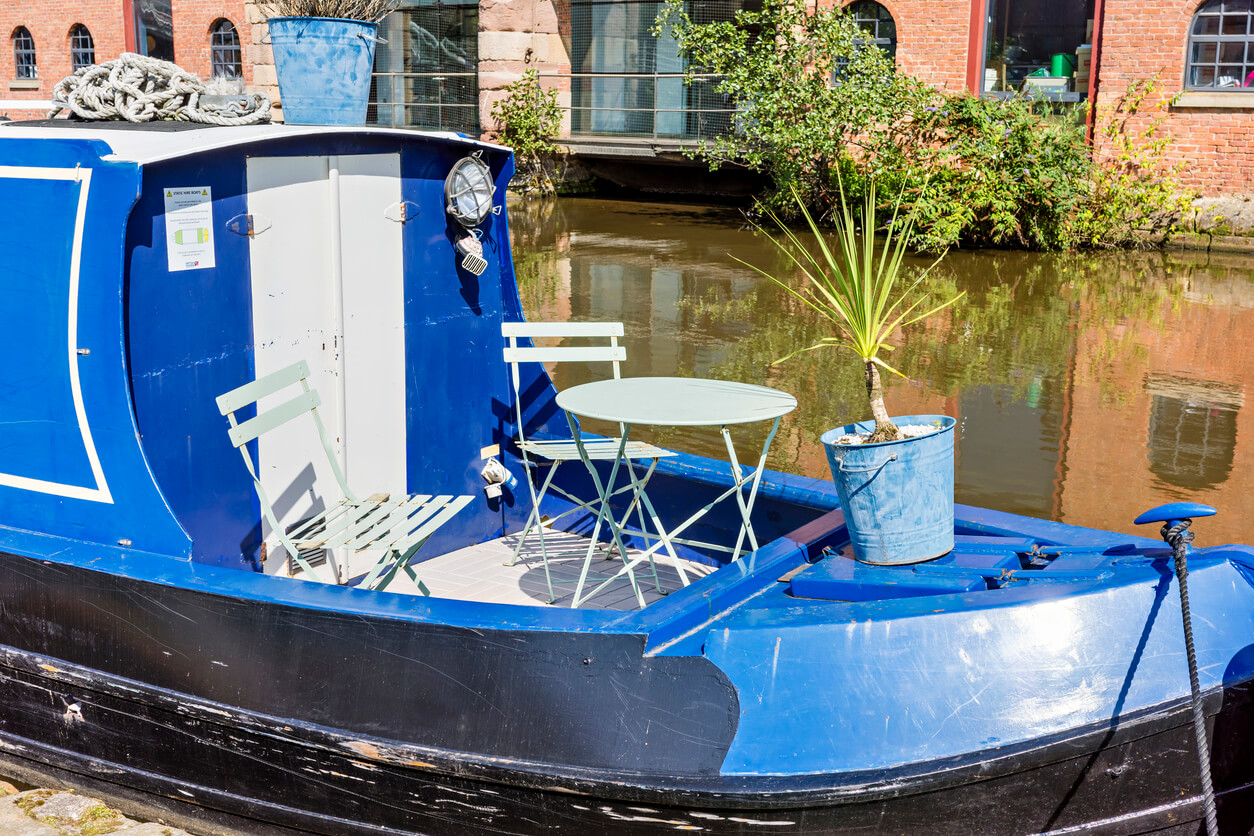A guide to narrowboat toilets
30 May 2025

Thinking about life on a narrowboat? Whether you’re long-term cruising or just the odd weekend adventure, there’s one thing you need to think about: the toilet. It might not be glamorous, but your narrowboat toilet makes all the difference when it comes to comfort and convenience.
In this guide, we’ll explore the different narrowboat toilet systems, explain how they work, discuss costs and maintenance, and help you choose the right toilet for your boat.
Types of toilets for narrowboats
There are four main narrowboat toilet options available: portable toilets, cassette toilets, pump-out toilets, and composting toilets. Each comes with its own set of pros and cons.
Portable toilets
Also known as camping toilets, these are the simplest option. A portable toilet has a detachable upper tank (for flushing water) and a lower tank (for waste). When the waste tank is full, you carry it to an Elsan disposal point and empty it. Simple, cheap, and ideal for occasional or light use.
Best for: Budget-conscious boaters and part-time cruisers.
Pros:
- Inexpensive
- Easy to install and replace
- No plumbing needed
Cons:
- Small waste capacity
- Needs emptying often
- Not ideal for liveaboard use
Cassette toilets
The best cassette toilet for narrowboat use is a step up from a portable loo. These are fixed in place and plumbed into the boat’s water supply for flushing. Waste is stored in a removable cassette below the toilet, which you slide out and empty at an Elsan point.
Some models have electric flush and even wheeled cassettes for easy transport. Many people who live on narrowboats use this system because of its simplicity and relatively low cost.
Best for: Full-time cruisers who want convenience without complication.
Pros:
- Affordable to buy and maintain
- Easy to use and replace parts
- No pump-out fees
Cons:
- Cassettes need emptying every couple of days (or daily for families)
- Needs regular access to disposal points
- Pump-out toilets
Pump-out toilets
A narrowboat pump-out toilet looks and feels like a traditional household toilet. It flushes waste into a large holding tank on board. When the tank is full (usually after a few weeks of use), you take your boat to a pump-out station and pay a fee to have it emptied.
These toilets offer the most comfort and need emptying less often, but they cost more to maintain.
Best for: Boaters who like comfort and don’t mind paying for it.
Pros:
- Large waste tank means fewer trips to dispose of waste
- Most like a home toilet
- Ideal for living on a narrowboat
Cons:
- Expensive installation
- Pump-outs cost around £15–£25
- Risk of tank blockages or odour issues
Composting toilets
The narrowboat composting toilet is the eco-warrior’s choice. A composting toilet separates solids and liquids instead of flushing waste away with water. Then begins the natural breakdown of waste into compost.
These systems are waterless and odourless when used correctly. They’re ideal for off-grid living, especially when combined with narrowboat solar panels to keep your energy needs sustainable. You can learn more about eco-living on the water with our narrowboat solar panel guide.
Best for: Off-grid living, eco-minded boaters, and remote cruising.
Pros:
- No need for pump-out or Elsan points
- Waterless system
- Great for the environment
Cons:
- Higher initial cost
- Needs good management (for example, adding sawdust, separating waste correctly)
- Not everyone’s cup of tea
For anyone going green, the best composting toilet for narrowboat living will have a fan for ventilation, separate compartments, and an easy way to dispose of liquids.
How composting toilets work on narrowboats
A compost toilet narrowboat system works by separating liquid and solid waste. Solids go into a compost chamber, while liquids are usually sent to a separate bottle or container.
It’s important to have good ventilation to keep things odour-free, and a small 12V fan helps keep the chamber dry. Once the solids chamber is full (usually after a few weeks), you dispose of the waste like regular rubbish, as long as it’s been fully composted.
These systems are water-free, so you save on your onboard water supply, and they’re particularly handy if you cruise in remote areas with limited services.
Water supply & waste disposal considerations
When choosing your canal boat toilets, it’s important to think about both water supply and waste disposal.
- Cassette and pump-out toilets use water for flushing, so you’ll need a reliable freshwater tank and regular refills.
- Composting toilets don’t use water, leaving your water supply for drinking, washing, and cooking.
- Portable toilets don’t connect to your boat’s water system, which makes them flexible but limited.
Most waste from cassette and pump-out toilets must be emptied at Elsan points or pump-out stations found at marinas or along the canal network.
If you’re going fully off-grid, a narrowboat composting toilet is a great choice, as you won’t need to find disposal points.
Related: Narrowboat interior ideas: smart design & space-saving tips
How to choose the right toilet for your narrowboat
With so many narrowboat toilet options, here are a few questions to help narrow down your choice:
- How often will you use the boat? If you’re a weekend cruiser, a cassette or portable toilet might be all you need.
- Where will you cruise? Remote areas with few facilities suit composting toilets, while marinas make pump-outs easier.
- Do you want comfort or simplicity? Pump-outs are closest to a home toilet. Compost toilets need more effort but offer more freedom.
- What’s your budget? Portable toilets start at around £50. Pump-out systems can cost £1,000+ to install.
To help you compare at a glance, here’s a breakdown of the key differences between the main toilet types:
| Toilet Type | Description | Price Range | Running Costs | Emptying Frequency | Best For |
|---|---|---|---|---|---|
| Portable | Basic, removable toilet with water & waste tanks | £50–£150 | Low (chemicals) | Every 1–2 days | Part-time cruisers, low budgets |
| Cassette | Fixed toilet with removable waste cassette | £300–£800 | Low (chemicals) | Every 2–3 days | Continuous cruisers, ease of use |
| Pump-Out | Plumbed toilet with large holding tank, pumped out at marinas | £800–£2,000+ | £15–£25 per pump-out | Every 2–4 weeks | Comfort seekers, liveaboards |
| Composting | Separates liquids & solids, no water needed, decomposes solid waste | £600–£1,200 | Very low (dry matter) | Every few weeks | Eco-living, off-grid, remote cruising |
Tips for maintenance and hygiene
Whatever system you choose, keeping your narrowboat toilet clean and odour-free takes a little effort. Here’s how to stay fresh:
- Use biodegradable chemicals in cassette or portable toilets to reduce smell and protect the environment.
- Empty regularly. Don’t wait until it’s full, as that’s when smells and leaks happen.
- Clean the cassette or tank with disinfectant and rinse thoroughly.
- Compost properly. Add dry materials like sawdust, and don’t put anything in the solids tank that won’t break down.
- Make sure you have good ventilation, especially for composting toilets. Fans help keep things dry and odour-free.
And don’t forget to keep your water tank and hoses clean too, especially if your toilet system relies on a steady water supply.
Costs and budgeting for narrowboat toilets
Here’s another quick look at the average costs for each toilet type:
| Toilet Type | Purchase Price | Running Costs |
|---|---|---|
| Portable | £50–£150 | Low (chemicals) |
| Cassette | £300–£800 | Low (chemicals) |
| Pump-Out | £800–£2,000+ | £15–£25 per pump-out |
| Composting | £600–£1,200 | Very low |
While composting and cassette systems save on pump-out fees, they may involve more hands-on work. Think about what suits your cruising type and budget.
For added peace of mind, don’t forget to get the right narrowboat insurance to cover breakdowns, repairs, and accidents. We offer specialist policies for inland boats, including dedicated narrowboat insurance.
Common issues to avoid
No toilet system is perfect, but make sure you avoid these common issues:
- Overfilling waste tanks (especially pump-out systems) can lead to leaks or expensive repairs.
- Check your seals and valves to avoid odours.
- Using the wrong chemicals can damage the toilet and harm the environment.
- Blocking composting systems by putting wipes or other non-biodegradable items in the toilet.
- Poor ventilation will lead to bad smells.
Proper use and regular maintenance will keep your narrowboat toilet running smoothly.
Choosing the right toilet for you
Your narrowboat toilet system might not be the most exciting part of your boat, but it’s one of the most important. Whether you go for the ease of a cassette, the comfort of a pump-out, or the eco-friendliness of a narrowboat composting toilet, the right toilet can make your experience more enjoyable.
Take your time to weigh up the pros, cons, and costs. Think about your boating lifestyle and what will make your narrowboat experience comfortable and convenient.
Specialist narrowboat insurance through Craftinsure
If you’re buying a canal boat such as a narrowboat or widebeam, you may want to protect your investment through specialist insurance.
Craftinsure arranges specialist narrowboat insurance that provides up to £5m third-party cover, and protects your boat against loss or damage from fire of theft. Get an instant online quote today.
Please note the information provided on this page should not be taken as advice and has been written as a matter of opinion. For more on insurance cover and policy wording, see our homepage.


